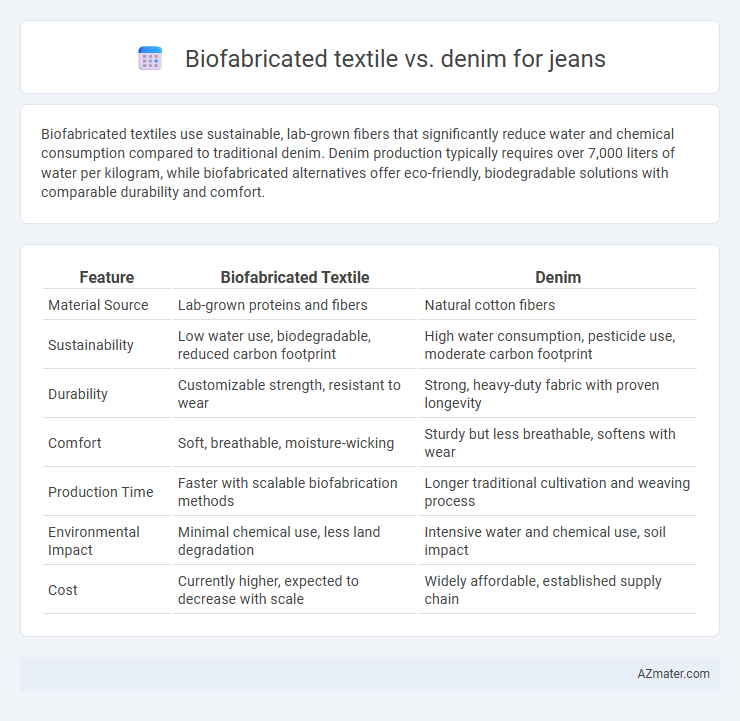Biofabricated textiles use sustainable, lab-grown fibers that significantly reduce water and chemical consumption compared to traditional denim. Denim production typically requires over 7,000 liters of water per kilogram, while biofabricated alternatives offer eco-friendly, biodegradable solutions with comparable durability and comfort.
Table of Comparison
| Feature | Biofabricated Textile | Denim |
|---|---|---|
| Material Source | Lab-grown proteins and fibers | Natural cotton fibers |
| Sustainability | Low water use, biodegradable, reduced carbon footprint | High water consumption, pesticide use, moderate carbon footprint |
| Durability | Customizable strength, resistant to wear | Strong, heavy-duty fabric with proven longevity |
| Comfort | Soft, breathable, moisture-wicking | Sturdy but less breathable, softens with wear |
| Production Time | Faster with scalable biofabrication methods | Longer traditional cultivation and weaving process |
| Environmental Impact | Minimal chemical use, less land degradation | Intensive water and chemical use, soil impact |
| Cost | Currently higher, expected to decrease with scale | Widely affordable, established supply chain |
Introduction to Biofabricated Textiles and Denim
Biofabricated textiles, created through sustainable biological processes such as microbial fermentation, offer an innovative alternative to traditional denim by significantly reducing water usage and carbon emissions during production. Denim, typically made from cotton fibers, remains a popular fabric for jeans due to its durability and classic texture but is associated with high environmental costs including extensive water consumption and pesticide use. The development of biofabricated textiles aims to maintain the aesthetic and functional qualities of denim while promoting eco-friendly manufacturing practices in the fashion industry.
Evolution of Materials in Jean Production
Biofabricated textiles revolutionize jean production by offering sustainable alternatives to traditional denim derived from cotton, reducing environmental impact through lower water usage and carbon emissions. Innovations in biofabrication enable the creation of customizable, durable fabrics with enhanced breathability and biodegradability, addressing the growing demand for eco-friendly fashion. Denim production continues to evolve with integration of bio-based fibers and microbial cellulose, setting new standards in resource-efficient and circular garment manufacturing.
Sustainability: Biofabricated Textiles vs Denim
Biofabricated textiles offer a significant sustainability advantage over traditional denim by utilizing lab-grown fibers that drastically reduce water consumption and greenhouse gas emissions. Denim production typically requires over 1,800 gallons of water per pair of jeans and involves intensive pesticide use, whereas biofabricated alternatives minimize environmental impact through controlled bioprocessing methods. This shift towards biofabrication supports circular economy principles and reduces the fashion industry's carbon footprint.
Environmental Impact Comparison
Biofabricated textiles for jeans significantly reduce water consumption and greenhouse gas emissions compared to traditional denim, which typically requires over 7,000 liters of water per pair and emits substantial CO2 during cotton cultivation and dyeing. The biodegradability and lower chemical usage in biofabricated materials minimize soil and water pollution, promoting sustainable fashion. In contrast, denim production heavily relies on synthetic dyes and pesticides, contributing to environmental degradation and resource depletion.
Manufacturing Processes and Resource Efficiency
Biofabricated textiles for jeans utilize microbial fermentation and lab-grown collagen, resulting in significantly lower water and energy consumption compared to traditional denim production, which relies heavily on cotton cultivation and intensive dyeing processes. The manufacturing process of biofabricated materials eliminates pesticide use and reduces greenhouse gas emissions by avoiding conventional cotton farming and chemical treatments typical of denim production. Resource efficiency is enhanced in biofabricated textiles through scalable, controlled environments that minimize land use and waste, contrasting with the resource-intensive and pollution-heavy water-intensive dyeing and finishing stages of denim jeans.
Performance: Durability and Comfort
Biofabricated textiles offer enhanced durability and breathability compared to traditional denim, making jeans more resistant to wear and tear while maintaining comfort throughout extended use. These innovative materials are engineered to provide superior moisture-wicking properties and flexibility, reducing irritation and increasing ease of movement. Denim, while robust and iconic for jeans, often lacks the adaptability and lightweight comfort found in biofabricated alternatives.
Aesthetic Qualities and Design Flexibility
Biofabricated textiles offer unique aesthetic qualities such as customizable textures, colors, and patterns that surpass traditional denim's classic indigo hues and rigid weave. Designers benefit from enhanced flexibility with biofabricated materials, allowing precise control over fabric thickness, softness, and finish to create innovative jean styles. Unlike denim, which relies on mechanical processing for design variation, biofabricated textiles integrate molecular-level customization, expanding creative possibilities in sustainable fashion.
Economic Considerations and Market Trends
Biofabricated textiles present a significant economic advantage over traditional denim for jeans by reducing water consumption and waste, leading to lower production costs and improved sustainability credentials. Market trends indicate increasing consumer demand for eco-friendly fashion, driving brands to adopt biofabricated materials that align with circular economy principles and reduce reliance on cotton cultivation. Investment in biofabricated textile technology and partnerships with innovative startups are accelerating, positioning this alternative as a competitive solution in the evolving denim market.
Consumer Perception and Adoption Challenges
Biofabricated textiles present a sustainable alternative to traditional denim, appealing to eco-conscious consumers who seek innovative, cruelty-free materials. However, challenges in consumer adoption arise due to concerns over durability, texture differences, and higher production costs compared to conventional denim. Market acceptance depends on educating consumers about the environmental benefits and improving the tactile and aesthetic qualities to match or surpass those of traditional jeans.
Future Prospects: Biofabricated Textiles as a Denim Alternative
Biofabricated textiles offer promising future prospects as sustainable alternatives to traditional denim in jean production, leveraging cellular agriculture to reduce environmental impact and water usage. These innovative materials mimic the durability and texture of conventional denim while enabling customization at the molecular level for enhanced performance. Continued advancements in biofabrication technology could lead to scalable, cost-effective production methods, making them viable substitutes for resource-intensive cotton denim.

Infographic: Biofabricated textile vs Denim for Jean
 azmater.com
azmater.com